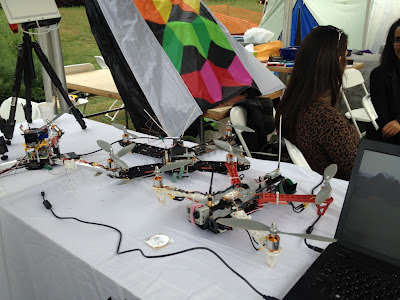Last week I attended the IEEE Vehicle Power and Propulsion Conference (VPPC) in Seoul. I haven't been to an academic conference since EVER '11, so it was interesting to see what's new in the world of traction systems.
 |
| Everything is greeeeeeeeen. |
There were some industry representatives present as well, most notably Hyundai/Kia, LG Chem, and Toyota. The cutaway car above is a Kia K5 (Optima, in the US) hybrid. Keynote speeches on the latest Hyundai/Kia and Toyota hybrid systems were interesting and offered comparisons to the full EV Nissan Leaf and the range-extended hybrid Chevy Volt. Left out was any mention of the Tesla Model S, which is presumably in a different price/performance range.
The conference venue was the very nice Seoul Olympic Parktel:
The Olympic Park was a nice exception to the otherwise huge and somewhat crowded city of Seoul (pop. 10.4M) and since I was jet-lagged and waking up at 5AM, I went for a walk through the park in the morning. I felt pretty stupid for not bringing my Talon quad with me - I thought there would be no open space in which to fly it around.
 |
| Oops, wrong. |
Anyway, back to traction systems. I went to the conference to present my Masters research, which is admittedly behind where I am currently at in terms of combining my version of field-oriented control and sensorless position estimation. In retrospect, I could have focused more on the sensorless stuff; there were not many other presentations on sensorless permanent magnet synchronous motor control.
There were a number of presentations on traction motors of all flavors. Most of the commercial hybrids have converged on internal permanent magnet synchronous motors (IPMSMs) for their combination of good torque density and good high-speed field-weakening characteristics. However, the anti-permanent magnet sentiment that I noticed at the SMMA conference a few years ago is still strong in the research world. There were many presentations on wound-field synchronous motors, switched reluctance motors, and induction motors.
 |
| Oh hi, Professor Kirtley. Haven't I seen this before? I feel less bad about presenting two-year-old research now. |
I do agree that for full-scale EVs, induction motors make a lot of sense. The cost of permanent magnets for a 200hp traction motor is significant. A well-designed induction motor (I'm looking at you, Prof. Kirtley) would still have a slightly lower specific power, but I don't think we're talking about a factor of two - more like 20-50% more weight per horsepower. But, the most significant weight hog in a full-scale EV is the battery pack and an extra 50lbs dedicated to motor weight isn't the end of the world. Furthermore, full-scale EVs can benefit from the inherent field-weakening capability and inverter fault tolerance of induction motors when operating at highway speeds. (PMSM field weakening to overcome back EMF limits is frighteningly dependent on the inverter not failing.)
For hybrids, or full-scale EVs with distributed motors (2WD/4WD), or for small-scale EVs like bikes, motorcycles, and scooters, I can't imagine switching away from the clearly superior performance of NdFeB magnets. I'm also not convinced a reduction of export of rare-earth materials means a drastic increase in price of finished products like magnets and motors from China. Maybe the price was just unreasonably low before? In any case, going backwards to older technology seems wrong to me.
One other exciting group of presentations (for me anyway) was from the semiconductor industry.
A representative from Infineon made the point that the mechanical complexity of the internal combustion engine is being replaced by complexity in the power electronics and control of electric motors in EVs. IGBTs are currently the semiconductors of choice in EV traction systems. Active research includes new packaging that eliminates bond wires (a major reliability bottleneck, since they are susceptible to thermal cycling stress) and enables double-sided cooling. Further in the future, high voltage/high temperature SiC MOSFET/JFET devices are coming (squee).
There was also a big emphasis on battery charging solutions. The standards for battery charging (levels, connectors) are mostly worked out now, so there are some real-world implementations coming on line. In fact, I saw one actually in use, unrelated to the conference, while out being a tourist in Seoul:
These chargers were at the top of a very large hill leading to Seoul Tower, which is a huge tourist trap and therefore serviced by lots of tour buses. At first I thought it was cool to see an electric (or maybe hybrid) bus charging at the top of the hill. But then I thought about how bad of an idea that could be. What if you start at the top of a large hill with a fully charged battery? Surely, the controller will not allow you to regen, and you will put higher-than-normal loads on the mechanical brakes. I'm sure they're designed to handle the full braking power of the bus with no regen, but still: wouldn't it make more sense to put the chargers at the bottom of the hill?
Anyway, if you do make it to the top of the hill, you are rewarded with a 30-minute wait to take an elevator to the observation deck and attempt to take pictures through a glass window with reflections of yourself and the gift shop behind you and fingerprints all over the glass. Most of the pictures come out like this:
With enough camera fidgeting I got this:
I would estimate that about 2/3 of the height comes from the large hill that the buses climb and only about 1/3 is the tower itself. It should give you an idea of how big Seoul is: this view only covers about half the city. Overall it was a great venue and an interesting conference. Here are some more pictures:

































